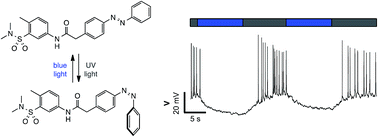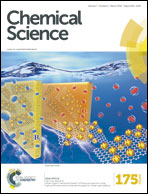Optical control of neuronal activity using a light-operated GIRK channel opener (LOGO)†
Abstract
G-protein coupled inwardly rectifying potassium (GIRK) channels are expressed throughout the human body and are an integral part of inhibitory signal transduction pathways. Upon binding of Gβγ subunits released from G-protein coupled receptors (GPCRs), GIRK channels open and reduce the activity of excitable cells via hyperpolarization. As such, they play a role in cardiac output, the coordination of movement and cognition. Due to their involvement in a multitude of pathways, the precision control of GIRK channels is an important endeavour. Here, we describe the development of the photoswitchable agonist LOGO (the Light-Operated GIRK channel Opener), which activates GIRK channels in the dark and is rapidly deactivated upon exposure to long wavelength UV irradiation. LOGO is the first photochromic K+ channel opener and selectively targets channels that contain the GIRK1 subunit. It can be used to optically silence action potential firing in dissociated hippocampal neurons and LOGO exhibits activity in vivo, controlling the motility of zebrafish larvae in a light-dependent fashion. We envisage that LOGO will be a valuable research tool to dissect the function of GIRK channels from other GPCR dependent signalling pathways.


 Please wait while we load your content...
Please wait while we load your content...